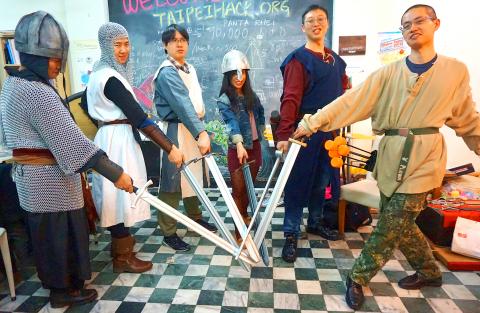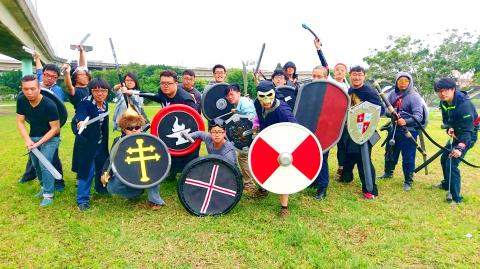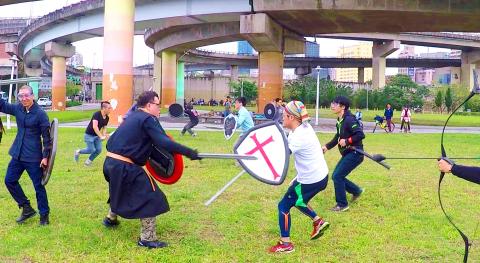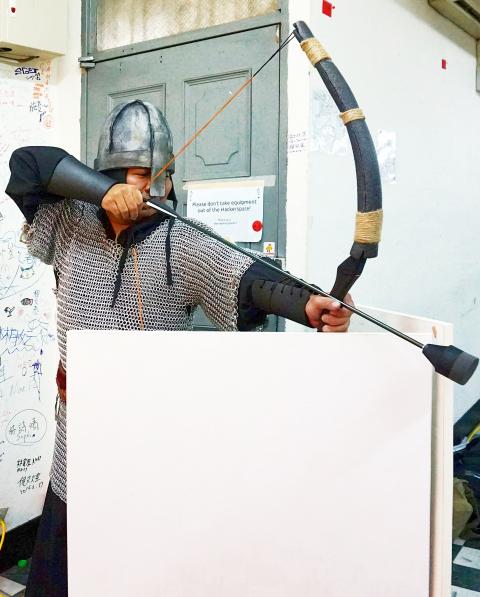Dennis Chou (周毓明) was walking down a street in Melbourne, Australia when he came across a gentleman dressed in medieval garb brandishing a foam sword. Naturally, he asked the man where he was going and the man said to war — their Live Action Role Play (LARP) group met every Friday night. He invited Chou to join.
LARP, a game which involves dressing up as fantasy characters that are often inspired by medieval knights and warriors, has been popular in Western countries since the 1990s, and recently, its popularity has spread to Taiwan. The LARP Group Taiwan, founded by Chou last year, will be meeting at the park by Dadaocheng Floodgate No. 3 (大稻埕三號水門處) on Sunday to stage a battle, and all are welcome to watch — and join the battle if you dare.
What started as a hobby during his working holiday in Australia soon became a preoccupation for Chou. Though he had been shooting air guns for years, it was through the LARP club in Melbourne that Chou found his true passion learning how to wield soft swords and shields and strategizing different battle formations. Chou even learned how to speak elvish, the constructed language invented by Lord of the Rings author J.R.R. Tolkien.

Photo: Dana Ter, Taipei Times
When I meet with Chou at Taipei Hackerspace, a co-working space for entrepreneurs to work on DIY projects, the LARPers are getting ready for this weekend’s battle by printing 3D weapons, sewing costumes and practicing fight moves, and I maneuver my way through power tools, caulking machines and satellite trackers to get to Chou’s desk.
“I’ve always enjoyed shooting air guns,” Chou tells me. “But with LARP, there is something more. It’s a team effort and there’s more room to be creative, which is important to me as I like to get really dramatic when I’m in battle.”
A TASTE FOR HISTORY AND FANTASY

Photo courtesy of LARP Group Taiwan
Fun, creativity and flexibility are what the LARPers strive for. Though most members’ characters are based on European folklore, they also allow characters such as Mongol soldiers or Japanese samurais into their game.
“It just makes things more interesting as it’s not something you’ll see in Western countries,” Chou says.
Chou is dressed as a crusader, an outfit which he fashioned himself. The tunic is made from discarded cloth and his helmet is made of Styrofoam.

Photo courtesy of LARP Group Taiwan
The 34-year-old Taipei native also dabbled in Historical European Martial Arts (HEMA) when he returned from Australia but didn’t like the rigidity, which included having to accurately reenact historical sword battles in Europe from medieval times to the Renaissance. He tried searching for a LARP club to join but couldn’t find one that was really dedicated, and that’s when he decided to form his own group.
“I wanted to introduce Taiwanese to the fun, mythical part of European culture,” Chou says. “Wizards, sorcerers, witch hunters, kings, warrior princesses, everything.”
Though cosplay has been popular in Taiwan for years — due to influence from Japanese pop culture — the LARPers say that what they are doing is not cosplay.

Photo: Dana Ter, Taipei Times
“There’s a tendency to get cosplay and LARP mixed up,” says LARP member Sachiel Peng (彭聖傑).
Dressed as a Central Asian warrior in chainmail armor that he purchased online, Peng says that while cosplay prioritizes dressing up and having your picture taken, LARP is not just about looking good.
“We don’t allow posers,” Peng jokes.
The trained martial artist says he gravitated towards LARP because it was somewhere in between martial arts and cosplay — “neither too serious nor too shallow.”
CRAFTING CHARACTERS
Devry Lin (林子軒) harbors a slightly different view.
“Sometimes I wish people would take LARP more seriously,” Lin tells me. “From the outside, we may look like a bunch of nerds, but what’s cool is that we’re also perpetuating old trades in a way.”
Lin shows me a couple of leather-bound notebooks that he’s made — the same material which he uses to make his arm guards. Had he not joined the LARP club, he wouldn’t have discovered his passion for handmade crafts. He also made his own tunic, though with some help from his mother’s seamstress friend.
When I ask Lin about his character, he hesitates. “Unfortunately, I don’t have much character development yet.”
As the game develops and one battle leads to another, the characters will begin to show more of their personalities and Lin says he hopes that his character will develop a “quirk” or something distinctive that he will be known for.
So far, Lin has revealed to the other members that his character is an Asian merchant who’s been washed ashore in the wilderness of Europe, a persona which he adopted when he started LARPing during his college days in Minnesota.
“Our characters grow and evolve as the game progresses and each characters’ backstories kind of feed off one another,” Lin says.
He adds that it can get a little confusing when more people join the club but they still let in anyone who wants to give it a try.

June 23 to June 29 After capturing the walled city of Hsinchu on June 22, 1895, the Japanese hoped to quickly push south and seize control of Taiwan’s entire west coast — but their advance was stalled for more than a month. Not only did local Hakka fighters continue to cause them headaches, resistance forces even attempted to retake the city three times. “We had planned to occupy Anping (Tainan) and Takao (Kaohsiung) as soon as possible, but ever since we took Hsinchu, nearby bandits proclaiming to be ‘righteous people’ (義民) have been destroying train tracks and electrical cables, and gathering in villages

Dr. Y. Tony Yang, Associate Dean of Health Policy and Population Science at George Washington University, argued last week in a piece for the Taipei Times about former president Ma Ying-jeou (馬英九) leading a student delegation to the People’s Republic of China (PRC) that, “The real question is not whether Ma’s visit helps or hurts Taiwan — it is why Taiwan lacks a sophisticated, multi-track approach to one of the most complex geopolitical relationships in the world” (“Ma’s Visit, DPP’s Blind Spot,” June 18, page 8). Yang contends that the Democratic Progressive Party (DPP) has a blind spot: “By treating any

This year will go down in the history books. Taiwan faces enormous turmoil and uncertainty in the coming months. Which political parties are in a good position to handle big changes? All of the main parties are beset with challenges. Taking stock, this column examined the Taiwan People’s Party (TPP) (“Huang Kuo-chang’s choking the life out of the TPP,” May 28, page 12), the Democratic Progressive Party (DPP) (“Challenges amid choppy waters for the DPP,” June 14, page 12) and the Chinese Nationalist Party (KMT) (“KMT struggles to seize opportunities as ‘interesting times’ loom,” June 20, page 11). Times like these can

Swooping low over the banks of a Nile River tributary, an aid flight run by retired American military officers released a stream of food-stuffed sacks over a town emptied by fighting in South Sudan, a country wracked by conflict. Last week’s air drop was the latest in a controversial development — private contracting firms led by former US intelligence officers and military veterans delivering aid to some of the world’s deadliest conflict zones, in operations organized with governments that are combatants in the conflicts. The moves are roiling the global aid community, which warns of a more militarized, politicized and profit-seeking trend